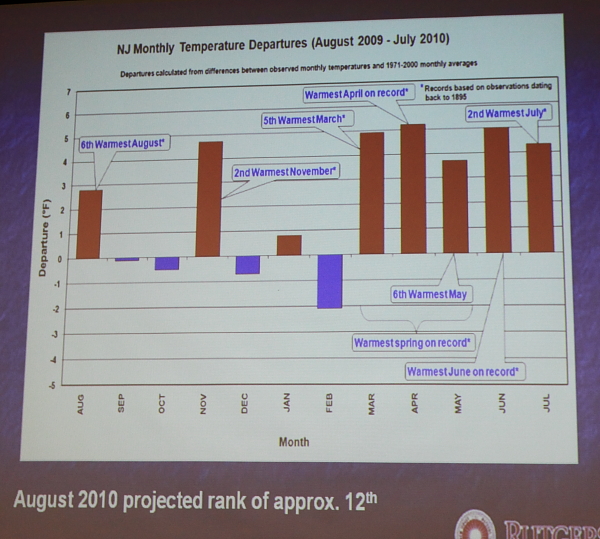No Rain In October – Little Rain On The Horizon
Climate Driven Extreme Weather Leads To Drought Emergency

Getting Warm. Source: Rutgers, State Climatologist Robinson. Presented at DEP drought hearing (8/25/10)
The chart above was from a DEP drought hearing back in 2010.
The Murphy DEP held a public hearing today on whether to issue a drought warning, see:
The hearing began with an eye opening briefing by DEP on current drought and water supply conditions and by State Climatologist Robinson on record low rainfall and high temperatures. It was virtually identical to his 2010 presentation (see above chart).
There was no rainfall in the entire month of October! There is now a 10 inch statewide rainfall deficit. (I will post the presentation when DEP does – here it is, watch.)
Curiously, Robinson attributed those extreme record breaking conditions to a “La Niña pattern” and changes to the jet stream – but he never once attributed the most significant factor, which is the climate emergency.
Climate scientists have been warning about exactly this kind of extreme weather for decades.
The DEP virtual hearing was attended by about 250 people, who provided over an hour of comments to DEP.
Several commenters stated that DEP was too slow to respond to the emerging drought and should have issued public advisories and mandatory water conservation restrictions months ago.
Commenters urged the DEP to recommend that the Governor declare a drought emergency now. That would empower DEP to mandate both supply and demand management options, like mandatory water conservation and curtailment of non-essential water uses, like watering lawns, golf courses, car washes, et al.
I asked a series of questions, mostly focused on the climate (time 55:30), water quality, public health, and ecological implications of the drought. DEP is doing very little to reduce these risks and impacts, and there is very little public awareness about them. (time 36:45)
I again provided recommendations from a performance Audit conducted by the State of California. They found that California regulators failed to incorporate climate science into the water supply forecasts and plans. They also found that drought preparation was inadequate. DEP repeats both errors.
For the full Audit, see:
https://www.auditor.ca.gov/reports/2022-106/index.html
During a drought, DEP can direct water purveyors to shift water supplies from one system to another. This raises serious issues that we saw in the Flint water emergency, where the change in the source water can leach and scour contaminants like lead out of the water distribution lines.
I criticized DEP’s failure to mandate the water purveyors implement the “Asset Management Plans”, particularly with respect to stopping leaks, which waste millions of gallons of water each day.
Much of NJ’s water supply comes from rivers. During a drought, from 75 – 95% of the flow of NJ rivers is treated industrial and municipal wastewater from sewage treatment plants. These low flows increase the concentrations of pollutants in the source water to unsafe levels, as drinking water treatment does not remove all chemicals and many are unregulated. Pumping that polluted river water to reservoirs creates additional problems, including algal blooms and the need for more treatment. (time 1:16:00)
Low stream and river flows also damage sensitive ecosystems.
Yet the DEP fails to impose regulatory protections to address these public health and ecological issues that are created by drought low flow conditions. Current DEP standards are based on outdated science about stream flows.
We ended our comments, third round, with a call for DEP to request that Governor Murphy declare a drought emergency. A dry winter will lead to truly dire conditions come spring.
Finally, retired DEP water supply planner Bob Kecskes made a very interesting point. He noted that a tiny fraction of water users, i.e. suburban homeowners, consume a disproportionate share of water demand due to watering suburban lawns. He compared their wasteful use (800 gallons per capita per day) with an urban home (50 gallons per capita per day).
Because all users must pay to build and maintain the drinking water infrastructure, the result is a huge subsidy from poor cities to wealthy suburbs, as urban residents pay for the profligate use of their suburban neighbors. This is another subtle form of environmental injustice.
Kesckes challenged DEP to conduct a study and adopt regulatory reforms.
